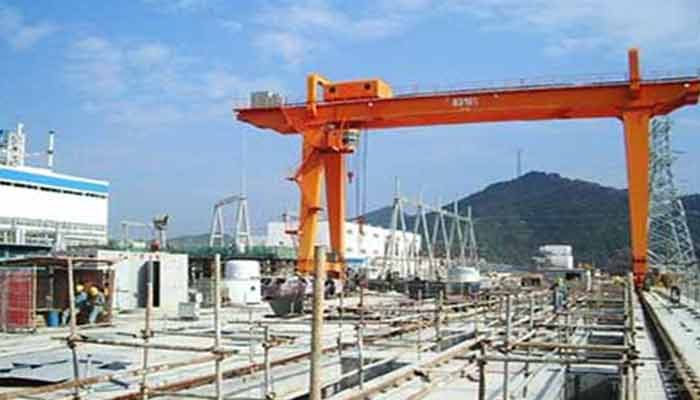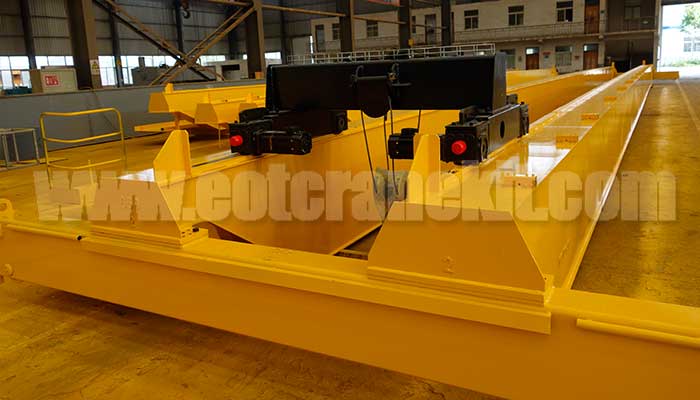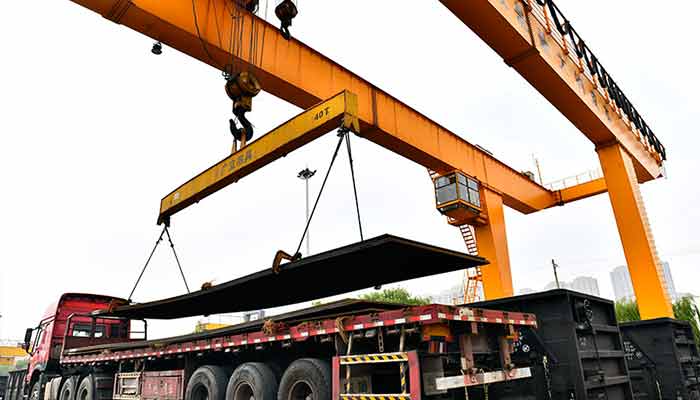
Overhead Cranes for Material Loading & Unloading from Trucks
Revolutionizing Material Handling: Overhead Cranes for Truck Loading and Unloading
Efficient material loading and unloading are fundamental to the seamless operation of countless industries worldwide. Whether it's the swift transport of goods in a warehouse or the precise handling of heavy materials in manufacturing, the need for precision and speed is paramount. In this quest for efficiency, the role of overhead cranes has emerged as a game-changer, revolutionizing the way materials are moved and managed.
Overhead cranes are more than just machines; they represent a critical cog in the wheels of industries where time is money. They streamline the flow of materials, ensuring that goods and components move swiftly and safely from point A to point B. In this comprehensive guide, we'll delve into the world of overhead cranes, exploring their versatility, benefits, and tailored applications across various industries.
When it comes to optimizing material loading and unloading processes, overhead cranes are the unsung heroes. These remarkable machines come in various forms, each tailored to meet the unique needs of different material handling applications. In this section, we'll introduce you to the various types of overhead cranes and explain how each one excels in specific material handling scenarios.
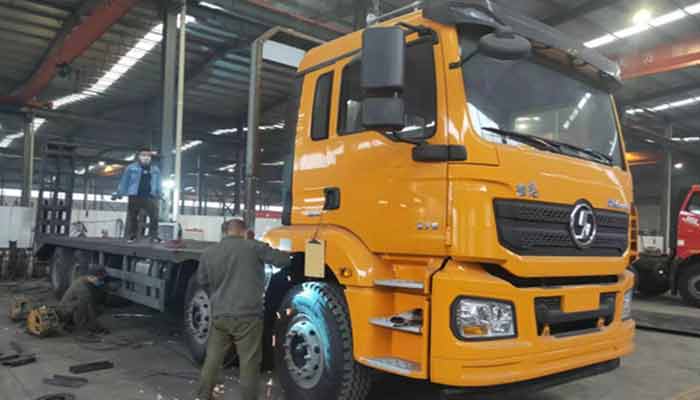
Single girder overhead crane for truck loading and unloading
Types of Overhead Cranes: Bridge cranes, also known as overhead traveling cranes, are available in various types, including single girder and double girder designs. They can be customized for specific applications with options like top-running or underhung configurations.
Different Types of Overhead Crane Design:
Single Girder Bridge Cranes: These cranes have one main horizontal girder that spans the runways. They are suitable for lighter loads and lower headroom applications.
Double Girder Bridge Cranes: These cranes have two main horizontal girders for increased load capacity and are suitable for heavier loads and longer spans.
Top-Running Bridge Cranes: The end trucks of the crane run along the top of the runway beams, providing stability and support for heavier loads.
Underhung Bridge Cranes: The end trucks of the crane are suspended from the runway beams, which can be a space-saving option for certain applications.
Features and Benefits:
Efficient material handling, as bridge cranes can move loads horizontally and vertically within their coverage area.
Customizable to match specific application requirements, such as variations in load capacity, span, and lifting height.
Typically equipped with electric hoists, offering precise load control and positioning.
Enhanced safety features, including limit switches, overload protection, and emergency braking systems.
Best Applications Environments and Conditions:
Manufacturing facilities, including automotive, aerospace, and heavy machinery production.
Warehouses for storage and distribution operations.
Any indoor environment with sufficient overhead space.
Applications that demand precise positioning and transportation of heavy loads.
Typical Loads Loading and Unloading from Trucks:
Bridge cranes are suitable for a wide range of loads, from small components to large machinery.
Commonly used for loading and unloading palletized goods, heavy equipment, and raw materials from trucks, ensuring efficient material flow within a facility.
Bridge cranes are renowned for their versatility and are widely used in various industries, particularly for efficiently handling diverse loads both horizontally and vertically. This makes them a popular choice for truck loading and unloading operations.
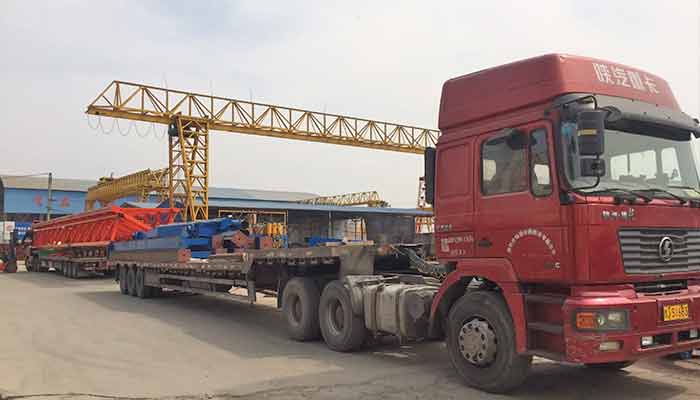
Gantry cranes are similar to bridge cranes but are supported by legs that run on the floor or ground-level tracks, as opposed to being suspended from an overhead structure. They are often used for outdoor applications, such as loading and unloading containers from trucks and ships.
Types of Gantry Cranes:
Single Girder Gantry Cranes: These cranes have a single horizontal girder for lighter loads and shorter spans.
Double Girder Gantry Cranes: These cranes feature two horizontal girders for heavier loads and longer spans.
Rubber-Tired Gantry Cranes (RTG): Mobile cranes with rubber tires, commonly used in ports and container handling.
Rail-Mounted Gantry Cranes (RMG): Gantry cranes that run on tracks, often used in container terminals and large logistics facilities.
Different Types of Gantry Crane Design:
Gantry cranes consist of a horizontal bridge (gantry) supported by vertical legs or posts at both ends.
The gantry bridge moves along floor-mounted tracks or wheels, allowing for horizontal mobility.
The hoist or trolley, which is used for lifting and lowering loads, moves along the gantry bridge, offering vertical movement and load positioning.
Features and Benefits:
Versatility and mobility, suitable for various applications and load capacities.
Outdoor and indoor use options depending on specific requirements.
Ideal for applications where overhead runways are not available or practical.
Customizable for specific needs, including load capacity, span, and outdoor weather resistance.
Mobile gantry cranes, like RTGs, provide flexibility and adaptability for port and container handling.
Best Application Environments and Conditions:
Container terminals and ports for efficient loading and unloading of shipping containers.
Outdoor applications such as construction sites, shipyards, and rail yards.
Locations that require precise positioning of heavy loads.
Typical Loads Loading and Unloading from Trucks:
Gantry cranes are well-suited for handling shipping containers from trucks and ships.
They are used to move heavy machinery, materials, and oversized loads in outdoor and construction settings.
In warehouses, they facilitate the loading and unloading of palletized goods and other heavy items.
Gantry cranes are a versatile and essential choice for various industries, particularly in outdoor applications and port facilities, where they efficiently handle heavy loads during the truck loading and unloading process.
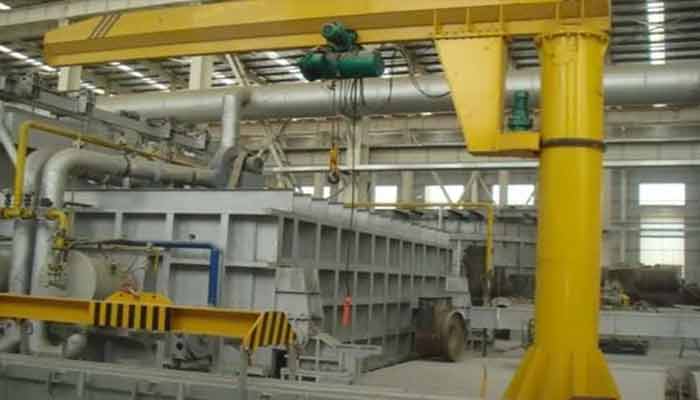
Jib Cranes: Jib cranes have a vertical pillar or wall-mounted boom with a hoist or trolley that can move loads horizontally. They are often used in smaller workspaces, where a full overhead crane system may not be feasible. Jib cranes are suitable for localized loading and unloading tasks.
Types of Jib Cranes:
Wall-Mounted Jib Cranes: These cranes are securely attached to a vertical wall or column and have a horizontal boom that can rotate.
Free-Standing Jib Cranes: These cranes are mounted on a freestanding vertical pillar and have a rotating horizontal boom.
Articulating Jib Cranes: These jib cranes have an additional pivot point on the boom, allowing for a wider range of movement and positioning.
Mast-Type Jib Cranes: These cranes feature a vertical mast or pillar for support and a horizontal boom that can rotate.
Different Types of Jib Crane Design:
Jib cranes consist of a vertical pillar or wall-mounted support structure with a horizontal boom.
The horizontal boom can rotate, providing a 360-degree coverage area.
A hoist or trolley is attached to the end of the boom for lifting and lowering loads.
Some jib cranes have an articulating design that allows for greater flexibility in load positioning.
Features and Benefits:
Ideal for localized and precise material handling tasks in compact spaces.
Efficient use of space, as they require minimal floor space and can be installed close to workstations or truck loading areas.
Cost-effective solution when a full overhead crane is not practical.
Easy to install and can be customized for specific load capacities and reach.
The rotating boom offers flexibility in load placement.
Best Applications Environments and Conditions:
Small manufacturing facilities with limited space.
Workstations or assembly lines where localized loading and unloading is required.
Truck loading docks for handling smaller loads or specific materials.
Environments where a full overhead crane system is unnecessary.
Typical Loads Loading and Unloading from Trucks:
Jib cranes are suitable for handling lighter loads in truck loading and unloading operations.
They are commonly used to load and unload smaller materials, equipment, and components in confined spaces.
Jib cranes are ideal for precise positioning of loads during assembly and production processes.
Jib cranes are a practical solution for smaller workspaces and localized material handling tasks, making them well-suited for truck loading and unloading operations that involve lighter loads or specific materials.
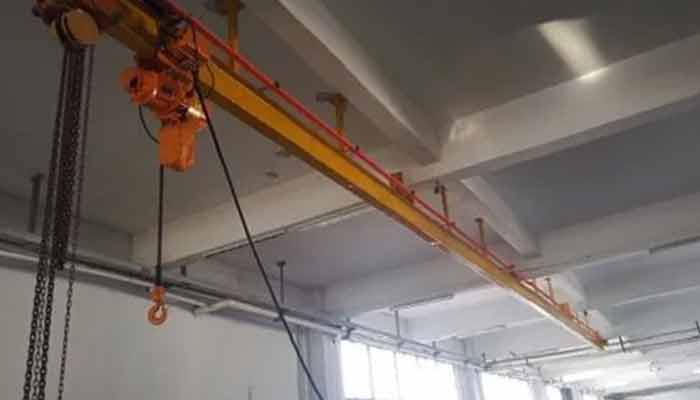
Monorail cranes consist of a single rail or beam, along which a hoist and trolley system moves. They are often used for linear and repetitive loading/unloading processes, such as moving materials along an assembly line or in a paint shop.
Types of Monorail Cranes:
Enclosed Track Monorail Cranes: These cranes have a fully enclosed track for the hoist and trolley, providing protection against contaminants and improving safety.
I-Beam Monorail Cranes: These cranes use a single I-beam as the rail on which the hoist and trolley move.
Patented Track Monorail Cranes: These cranes have a specific, patented track design that offers smooth movement and precise load positioning.
Power and Free Monorail Systems: These systems consist of a continuous track with multiple carriers that can be independently controlled, allowing for complex material handling.
Different Types of Monorail Crane Design:
Monorail cranes have a single, elevated rail that serves as the track for the hoist and trolley.
The hoist and trolley system runs along the rail, providing linear movement.
Some systems feature multiple carriers that can be interconnected and disengaged as needed, increasing flexibility in material handling.
Features and Benefits:
Ideal for linear and repetitive material handling processes.
Efficient use of space, as they require minimal floor space and can be installed above workstations or assembly lines.
Enclosed track systems protect the hoist and trolley from contaminants and reduce maintenance needs.
Patented track designs offer smooth, precise movement.
Power and Free systems provide flexibility in material handling and can be used for various production processes.
Best Applications Environments and Conditions:
Manufacturing facilities with assembly lines and production processes that require materials to move linearly.
Paint shops and finishing lines, where materials need to move through various stages.
Cleanroom environments where contamination control is crucial.
Locations with limited floor space, as monorail cranes can be installed above equipment or work areas.
Typical Loads Loading and Unloading from Trucks:
Monorail cranes are suitable for handling materials and components during truck loading and unloading processes.
They are commonly used for moving parts and products along assembly lines or through finishing processes.
Monorail cranes are ideal for applications where repetitive, linear movement of materials is required.
Monorail cranes are a practical solution for environments where materials need to move linearly, making them well-suited for repetitive loading and unloading processes and assembly line operations.
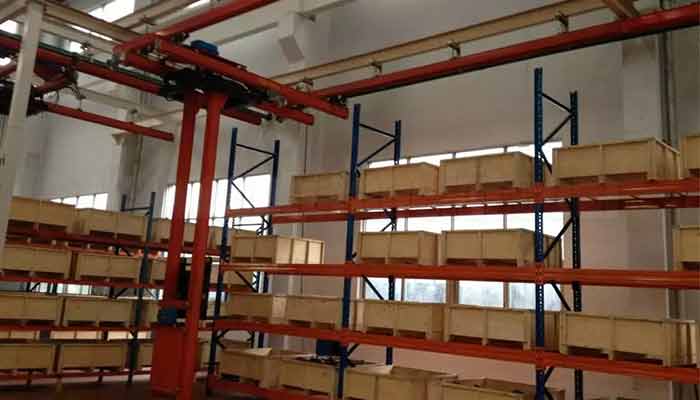
Stacker Cranes: Stacker cranes are typically used in automated warehousing systems for high-density storage and retrieval of palletized goods. They can efficiently load and unload pallets from trucks and place them in high-rack storage.
Types of Stacker Cranes:
Single-Mast Stacker Cranes: These cranes have one vertical mast for lifting and lowering pallets.
Double-Mast Stacker Cranes: These cranes feature two vertical masts for increased stability and heavier load capacities.
Automated Guided Vehicle (AGV) Stacker Cranes: Mobile stacker cranes that move on wheels or tracks and are guided by automation systems.
Crane and Conveyor Integrated Stacker Cranes: Stacker cranes that incorporate conveyor systems for efficient material flow.
Different Types of Stacker Crane Design:
Stacker cranes typically have a vertical mast or multiple masts that support the lifting mechanism.
The lifting mechanism can include forks, platforms, or specialized attachments for handling various types of loads.
Stacker cranes are often integrated with warehouse management software for automation and precise control.
Features and Benefits:
High-density storage capabilities, making the most of available warehouse space.
Efficient pallet retrieval and placement in high racks, reducing manual labor and increasing storage capacity.
Automated operation for precise load positioning and reduced human intervention.
Integration with warehouse management systems (WMS) for inventory control and order fulfillment.
Improved safety and reduced risk of damage to goods due to automated processes.
Best Applications Environments and Conditions:
Automated warehouses with high-density storage requirements, such as distribution centers and e-commerce fulfillment centers.
Environments where inventory management and order fulfillment efficiency are essential.
Locations with limited floor space that need to maximize vertical storage capacity.
Applications where controlled access to goods and minimal product handling are crucial.
Typical Loads Loading and Unloading from Trucks:
Stacker cranes excel at loading and unloading palletized goods from trucks, efficiently moving them into and out of high racks.
They are well-suited for handling a wide range of products, from consumer goods to industrial materials.
Stacker cranes play a crucial role in the automation of distribution and fulfillment processes.
Stacker cranes are a critical component of automated warehousing and distribution systems, offering high-density storage and efficient loading and unloading of palletized goods from trucks and containers. They are especially valuable in environments where space optimization and automation are key priorities.
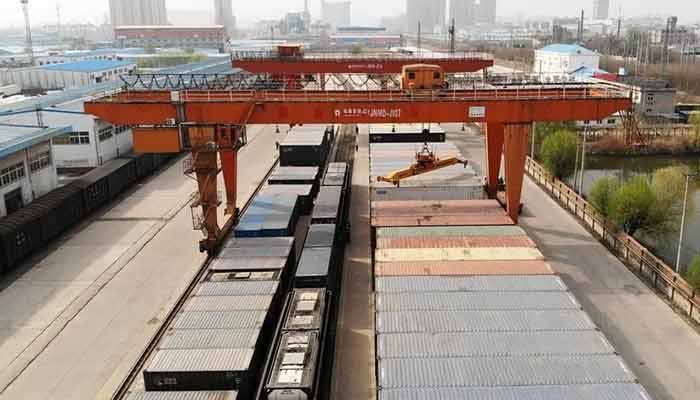
Container Cranes
Container cranes, also known as ship-to-shore cranes, are specialized gantry cranes designed for loading and unloading shipping containers from ships onto trucks or trains. They are commonly seen at ports and container terminals.
Types of Container Cranes:
Ship-to-Shore (STS) Cranes: These are large, towering cranes specifically designed for transferring containers between ships and dockside infrastructure.
Rail-Mounted Gantry Cranes (RMG): RMG cranes run on tracks and are used in intermodal facilities for transferring containers between ships, trucks, and trains.
Rubber-Tired Gantry Cranes (RTG): RTG cranes are mobile and use rubber tires for mobility. They are often used in container yards.
Straddle Carriers: Straddle carriers are mobile machines with legs that can straddle containers for lifting and moving. They are used for container handling in various environments.
Different Types of Container Crane Design:
Container cranes are typically gantry cranes with specialized features for handling shipping containers.
STS cranes have high lifting heights and long booms to reach containers on large ships.
RMG and RTG cranes have multiple legs and wheels for mobility and can handle containers in storage yards.
Straddle carriers have legs that straddle containers and can move containers within a terminal or yard.
Features and Benefits:
High lifting capacities to handle heavy containers.
Ability to efficiently transfer containers between ships, trucks, and trains.
Specialized spreader bars to securely grip and move containers.
Precision control for safe and accurate container handling.
Mobile options for flexible container management within terminals.
Best Applications Environments and Conditions:
Ports and container terminals for efficient transshipment of containers.
Intermodal facilities where containers need to be transferred between different modes of transportation.
Container storage yards for organizing and managing container inventory.
Environments with a high volume of container handling, such as major shipping hubs.
Typical Loads Loading and Unloading from Trucks:
Container cranes are designed to handle standardized shipping containers, typically 20-foot and 40-foot containers.
They are used to load and unload containers from trucks and onto ships, ensuring efficient material flow in busy port and container terminal operations.
Container cranes play a pivotal role in global logistics by facilitating the transfer of goods between different modes of transportation.
Container cranes are essential for the global movement of goods, enabling efficient loading and unloading of shipping containers from trucks, ships, and trains. They are critical components of port and container terminal operations and are designed to handle heavy containers with precision and safety.
Hot sale tonnages of overhead cranes used for truck loading and unloading typically range from 5 tons to 50 tons, depending on the specific application and industry. Here are some of the common tonnages and their associated crane designs and configurations:
- 5-Ton Overhead Crane: These are suitable for light to moderate material handling needs, often found in smaller warehouses or workshops. They are typically single girder bridge cranes.
- 2. 10-Ton Overhead Crane: These are versatile and can handle a wide range of materials. They are often single or double girder bridge cranes and commonly used in manufacturing facilities and storage yards.
- 20-Ton Overhead Crane: Designed for heavier loads, 20-ton overhead cranes are used in industries like steel, automotive, and construction. They are often double girder bridge cranes to provide the necessary strength.
- 30-Ton Overhead Crane: These are used for heavy-duty material handling in industries such as shipbuilding, foundries, and steel mills. They are typically double girder bridge cranes for superior lifting capacity.
- 50-Ton Overhead Crane: These are some of the largest overhead cranes used for truck loading and unloading. They are crucial in industries that deal with massive loads like shipyards, heavy machinery, and aerospace manufacturing.
Overhead crane for different trucks loading & unloadings
Truck loading and unloading operations often require the coordination of various types of trucks and equipment to ensure efficient and safe material handling. While overhead cranes are valuable for lifting and positioning heavy loads, there are several types of trucks commonly used in conjunction with overhead cranes for these tasks. Here are some of the trucks that are often involved in the process:
- Flatbed Trucks: Flatbed trucks are used to transport palletized or large, heavy items to and from the loading and unloading area. Overhead cranes can be used to lift loads onto or off of flatbed trucks. The combination of overhead cranes and flatbed trucks is common in manufacturing facilities and industrial yards.
- Forklift Trucks: Forklifts play a vital role in moving palletized goods within the truck or around the loading dock area. Overhead cranes can assist forklifts in lifting and positioning heavy loads onto the truck bed or in the warehouse.
- Reach Stackers: Reach stackers are specialized container-handling trucks commonly used in container terminals and ports. Overhead cranes are often employed to transfer containers to and from reach stackers for truck loading and unloading.
- Container Chassis: Container chassis are trailers designed to transport shipping containers. Overhead cranes can be used to load or unload containers onto chassis for road transportation.
- Dump Trucks: In industries like construction and mining, dump trucks are frequently used to transport materials such as sand, gravel, and debris. Overhead cranes can load these materials into the dump truck's bed.
- Tow Trucks: Tow trucks are used to move vehicles that may be broken down or need to be relocated. Overhead cranes can assist in positioning vehicles onto the tow truck's bed for transport.
- Refrigerated Trucks (Reefer Trucks): Overhead cranes can help load and unload temperature-sensitive goods onto and from refrigerated trucks, ensuring they are efficiently placed in the temperature-controlled environment.
- Tanker Trucks: Tanker trucks are designed to transport liquids or gases. Overhead cranes can assist in loading and unloading the contents of tanker trucks, especially in industries like chemicals or petroleum.
- Pallet Jacks: Pallet jacks are used to move pallets within the truck or around the loading dock area. Overhead cranes can help in loading or unloading heavy pallets from trucks when needed.
- Container Handlers: Container handlers, used in ports and container terminals, may require assistance from overhead cranes to load or unload containers onto/from trucks and other transport vehicles.
The specific trucks needed for truck loading and unloading operations depend on the nature of the materials being handled, the industry, and the logistics of the facility. Overhead cranes are valuable for their lifting and positioning capabilities and can work in tandem with these trucks to ensure efficient and safe material handling in various applications.
Tailored Overhead Crane for Different Material Loading and Unloading from Trucks
Overhead cranes are versatile material handling devices commonly used in various industries for loading and unloading a wide range of loads or objects. The typical loads that require the operation of overhead cranes include:
Palletized Goods
When it comes to efficiently handling palletized goods in warehouses, precision, and speed are of the essence. This is where overhead cranes come into their element, offering tailored solutions that optimize the loading and unloading of palletized goods. Let's delve into how these cranes play a pivotal role in warehouse operations.
Optimizing Palletized Goods Handling:
Warehouses are bustling hubs of activity, and palletized goods are the lifeblood of these operations. Overhead cranes bring efficiency to this vital process. They can swiftly and accurately move pallets of goods, whether they're boxes, cartons, or materials placed on pallets.
Types of Cranes Suitable for Palletized Goods:
Several types of overhead cranes are well-suited for handling palletized goods in warehouses:
- Bridge Cranes: These versatile cranes are commonly used in warehouses for palletized goods due to their ability to cover a wide area. Their horizontal bridge can efficiently move pallets within the workspace.
- Stacker Cranes: In high-density warehousing scenarios, stacker cranes shine. These automated cranes are designed to retrieve and store palletized goods with precision, reducing the need for manual labor.
- Gantry Cranes: For outdoor warehouses or open-air storage, gantry cranes provide the mobility and lifting capacity to manage palletized goods effectively.
Applications and tailored lifting devices
Overhead cranes are frequently used in warehouses and distribution centers to load and unload palletized goods. These goods can include items like boxes, cartons, and materials placed on pallets.
Best Applications Environments and Conditions:
Warehouses and distribution centers requiring efficient palletized goods handling.
Manufacturing facilities with assembly lines and storage needs.
Locations with specific load positioning requirements, such as within racking systems.
Environments with space constraints that benefit from overhead material handling.
Typical Below Hook Devices used for Palletized Goods Handling:
Lifting Hooks: Standard hooks for attaching to pallets, containers, or other loads.
Pallet Lifters: Designed to handle pallets with precision, often with adjustable arms.
Vacuum Lifters: Used for lifting and handling items with smooth surfaces, like glass or certain cartons.
Magnetic Lifters: Equipped with magnets for lifting metal materials and containers.
This format can be adapted for each of the categories you listed, providing an overview of the suitable overhead crane types, configurations, features, applications, and below-hook devices for each specific type of load or object.
Benefits of Using Overhead Cranes for Palletized Goods:
The benefits of employing overhead cranes for handling palletized goods are manifold:
- Efficiency: Overhead cranes can swiftly move pallets to their designated locations, minimizing downtime and ensuring a continuous flow of goods.
- Accuracy: Precision is key when dealing with palletized goods, and overhead cranes are equipped with features like precise controls to ensure accurate placement.
- Reduced Labor: Overhead cranes minimize the need for manual labor, reducing the risk of injuries and streamlining operations.
- Space Optimization: Overhead cranes make the most of vertical space in warehouses, allowing for efficient use of floor space.
- Safety: Modern overhead cranes are equipped with advanced safety features to protect both goods and personnel.
In a warehouse setting, overhead cranes represent the future of material handling. They combine speed, accuracy, and safety, ensuring that palletized goods move smoothly through the supply chain.
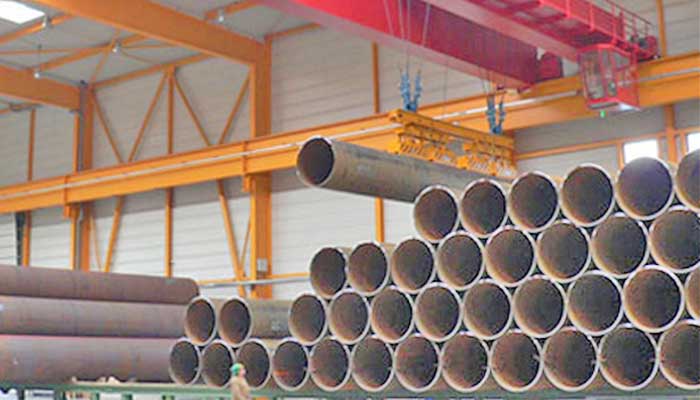
Steel and Metal Products
The steel and metal industry is one of the pillars of modern manufacturing, but its success relies on precision, strength, and the ability to handle heavy and often unwieldy materials. Overhead cranes are not just an asset in this industry; they are its backbone, ensuring that steel and metal products move efficiently through the production process. Let's explore the pivotal role that overhead cranes play in this sector and the key features and benefits they bring to the table.
The Pivotal Role in Steel and Metal Industries:
The steel and metal industry operates on a grand scale. Materials such as steel beams, coils, and metal components are integral to construction, manufacturing, and infrastructure development. To move these materials effectively, the industry needs machines that can handle substantial loads. Overhead cranes step up to the plate.
Overhead cranes are commonly used for loading and unloading steel and metal products, including coils, bars, plates, and other heavy materials.
Types of Overhead Cranes used for Steel and Metal Products:
Double Girder Overhead Cranes: These cranes provide the strength and capacity needed for lifting heavy steel materials.
Magnetic Overhead Cranes: Equipped with electromagnetic lifting attachments for secure handling of ferrous metals.
Specialized Coil Handling Cranes: Designed with custom attachments to handle steel coils efficiently.
High-Temperature Cranes: Used in metal foundries for handling materials at elevated temperatures.
Features and Benefits:
High load capacity and durability for safe and efficient steel and metal handling.
Magnetic cranes ensure a secure grip on ferrous metals, reducing the risk of drops.
Customized attachments and configurations meet the unique requirements of metal processing facilities.
Heat-resistant components in high-temperature cranes for handling hot metal materials.
Best Applications Environments and Conditions:
Steel mills, metal fabrication facilities, and foundries.
Locations with heavy steel and metal processing requirements.
Environments where precise control of metal handling is essential.
High-temperature applications in metal production.
Typical Below Hook Devices used for Steel and Metal Products Handling:
Electromagnetic Lifters: Powerful magnets for secure handling of ferrous materials.
Coil Handling Hooks: Custom hooks designed for safely lifting and transporting steel coils.
Grab Buckets: Suitable for handling bulk steel scrap and irregularly shaped metal pieces.
Tongs and Clamps: Used for gripping and moving metal bars, beams, and plates.
Key Features and Benefits for Steel and Metal Material Handling:
- High Load Capacity: Overhead cranes designed for the steel and metal industry are equipped with high load capacities to handle the weight of heavy materials. Whether it's moving steel beams or transferring metal coils, these cranes excel in safely managing substantial loads.
- Specialized Hooks and Attachments: Steel and metal materials often come in unconventional shapes and sizes. Overhead cranes are equipped with specialized hooks and attachments designed to securely grip these materials, ensuring their safe movement.
- Advanced Controls: Precise control is essential when handling heavy materials. Overhead cranes are equipped with advanced control systems that allow for accurate positioning, reducing the risk of accidents and material damage.
- Efficiency: The efficiency of material handling in the steel and metal industry can significantly impact production timelines. Overhead cranes enable quick and efficient transfers, minimizing downtime and maximizing productivity.
- Reduced Labor: The steel and metal industry's material handling processes often require substantial manual labor. Overhead cranes can reduce the need for manual intervention, enhancing safety and efficiency while decreasing labor costs.
- Precise Material Placement: In manufacturing and construction, precise material placement is crucial. Overhead cranes offer the control and precision required to position materials exactly where they're needed, eliminating errors and minimizing waste.
The role of overhead cranes in the steel and metal industry extends beyond mere material handling; it's about streamlining operations, increasing efficiency, and ensuring that the sector's products meet the high standards of quality and precision demanded by various industries.
Automotive Components
The automotive industry is all about precision, efficiency, and customization. As a sector that relies on the intricate assembly of countless components, it demands a material handling solution that can deliver all three. Overhead cranes rise to the challenge, enhancing the automotive industry in numerous ways. In this section, we'll explore how overhead cranes contribute to the automotive sector's success, their role in precision and customization, and the benefits, safety enhancements, and efficiency improvements they bring to the table.
Automotive Components: Overhead cranes are used in the automotive industry for handling various components, including engines, chassis, and body panels.
Types of Overhead Cranes used for Automotive Components:
Single Girder Overhead Cranes: Efficient for moving lighter automotive components within manufacturing facilities.
Double Girder Overhead Cranes: Ideal for lifting heavy automotive components, providing high capacity.
Jib Cranes: Used for localized handling of small components during assembly.
Best Application Environments and Conditions:
Automotive manufacturing facilities, including assembly and production lines.
Locations where continuous and accurate component handling is essential.
Typical Below Hook Devices used for Automotive Component Handling:
Customized Hooks: Designed to securely attach and lift various automotive components.
Specialized Lifting Attachments: Engine lifters, chassis grabbers, and body panel hooks.
Enhancing the Automotive Industry with Precision and Customization:
The automotive industry is driven by innovation, and the production of vehicles is a highly precise and customized process. It involves the assembly of thousands of parts, each contributing to the final product. Overhead cranes play a crucial role in ensuring that these components are moved with utmost accuracy and efficiency.
- Customized Design: Overhead cranes used in the automotive sector are often customized to suit the specific needs of the assembly line. This may involve adapting the crane's lifting capacity, reach, or control features to ensure it integrates seamlessly into the production process.
- Precision Handling: Precision is paramount when dealing with automotive components. Overhead cranes are equipped with advanced control systems that allow for the precise positioning and movement of components, reducing the risk of damage and errors in the assembly process.
Benefits, Safety, and Efficiency Improvements via Overhead Cranes:
- Overhead cranes bring a range of benefits to the automotive industry, enhancing safety, efficiency, and the overall production process.
- Enhanced Safety: Overhead cranes are designed with safety in mind. They feature built-in safety mechanisms to protect both materials and workers, reducing the risk of accidents and injuries.
- Efficiency: Efficiency is crucial in automotive assembly. Overhead cranes can move components with speed and accuracy, reducing assembly line downtime and ensuring a continuous production flow.
- Custom Solutions: Overhead cranes can be customized to fit seamlessly into the automotive production line. This adaptability allows manufacturers to optimize their operations.
- Reduced Labor: By automating material handling, overhead cranes reduce the need for manual labor, cutting labor costs and minimizing the risk of human error.
The integration of overhead cranes into the automotive industry isn't just about moving components; it's about optimizing production, improving safety, and enhancing the overall quality of vehicles. The precise handling and adaptability of these cranes ensure that every component fits perfectly into the final product.
Construction Materials
In the world of construction, efficiency, safety, and precision are paramount. Handling materials like concrete blocks and steel beams requires specialized equipment that can not only manage substantial loads but also ensure materials are precisely placed. Overhead cranes have become indispensable in the construction industry, streamlining the movement of these heavy materials. In this section, we'll explore the role of overhead cranes in construction, focusing on the handling of materials such as concrete blocks and steel beams. We'll also delve into the benefits they bring and the configurations that make material handling in construction projects efficient.
Construction Materials: Overhead cranes are employed in the construction industry for moving materials like concrete blocks, pipes, and structural components.
Types of Overhead Cranes used for Construction Materials:
Double Girder Overhead Cranes: Ideal for lifting heavy construction materials such as structural steel.
Gantry Cranes: Used in outdoor construction sites for flexibility in material handling.
Telescopic Cranes: Suitable for lifting and positioning materials at heights.
Best Application Environments and Conditions:
Construction sites for residential, commercial, and industrial projects.
Locations with a need for versatile material handling in outdoor settings.
Typical Below Hook Devices used for Construction Material Handling:
Lifting Beams: Customized beams designed to handle various construction materials.
Concrete Block Grabs: Specifically designed to grip and transport concrete blocks.
Pipe Hooks: Designed for the safe lifting and transport of pipes.
Overhead Cranes in Construction:
Construction sites are dynamic environments where materials need to be moved swiftly, safely, and accurately. Overhead cranes offer the perfect solution for handling a range of construction materials, including:
- Concrete Blocks: These heavy blocks are essential in building foundations and structures. Overhead cranes can lift and transport concrete blocks with ease, ensuring they are precisely placed in the construction process.
- Steel Beams: Steel is a primary building material. Overhead cranes can handle the substantial weight of steel beams, moving them into position for various construction tasks.
- Benefits and Configurations for Efficient Construction Material Handling:
- The use of overhead cranes in construction provides several benefits and is supported by various configurations:
- Safety: Safety is a priority in construction. Overhead cranes come with safety features that protect workers and materials, reducing the risk of accidents.
- Precision Handling: In construction, materials need to be placed with precision. Overhead cranes can achieve this level of accuracy, ensuring materials are positioned exactly where they're needed.
- Customized Configurations: Overhead cranes can be tailored to suit the specific needs of construction projects. They can be configured with the right lifting capacity, reach, and control features to optimize material handling.
- Efficiency: Construction projects often have tight deadlines. Overhead cranes expedite the process, reducing downtime and ensuring the timely completion of projects.
- Reduced Labor: The construction industry involves strenuous manual labor. Overhead cranes reduce the need for manual material handling, enhancing both efficiency and worker safety.
The integration of overhead cranes in construction projects is a testament to the versatility and adaptability of these machines. They ensure that even the heaviest and most unwieldy construction materials are moved with ease, contributing to the efficiency and success of construction endeavors.
In the upcoming sections, we'll explore how overhead cranes are customized for handling materials in various other applications, such as shipping containers, heavy machinery, automotive components, and more, each with its specific requirements that overhead cranes are uniquely equipped to address.
Shipping Containers
Overhead cranes, especially container cranes, are essential for loading and unloading standardized shipping containers from ships, trucks, and trains at ports and container terminals.
Types of Overhead Cranes used for Shipping Containers:
Container Cranes (Ship-to-Shore Cranes): Specialized gantry cranes designed for efficient container handling in port and terminal environments.
Reach Stackers: Versatile container-handling trucks commonly used for moving containers within terminals, often requiring coordination with overhead cranes.
Gantry Cranes: Used for container handling within container yards or rail yards.
Best Application Environments and Conditions:
Ports, container terminals, and intermodal facilities handling international shipping containers.
Locations with a high volume of containerized cargo.
Typical Below Hook Devices used for Container Handling:
Spreader Bars: Secure attachments for lifting and handling containers by their corner castings.
Twistlocks: Locking mechanisms used to secure containers during lifting and transport.
Enhancing the Automotive Industry with Precision and Customization:
The automotive industry is driven by innovation, and the production of vehicles is a highly precise and customized process. It involves the assembly of thousands of parts, each contributing to the final product. Overhead cranes play a crucial role in ensuring that these components are moved with utmost accuracy and efficiency.
- Customized Design: Overhead cranes used in the automotive sector are often customized to suit the specific needs of the assembly line. This may involve adapting the crane's lifting capacity, reach, or control features to ensure it integrates seamlessly into the production process.
- Precision Handling: Precision is paramount when dealing with automotive components. Overhead cranes are equipped with advanced control systems that allow for the precise positioning and movement of components, reducing the risk of damage and errors in the assembly process.
- Benefits, Safety, and Efficiency Improvements via Overhead Cranes:
- Overhead cranes bring a range of benefits to the automotive industry, enhancing safety, efficiency, and the overall production process.
- Enhanced Safety: Overhead cranes are designed with safety in mind. They feature built-in safety mechanisms to protect both materials and workers, reducing the risk of accidents and injuries.
- Efficiency: Efficiency is crucial in automotive assembly. Overhead cranes can move components with speed and accuracy, reducing assembly line downtime and ensuring a continuous production flow.
- Custom Solutions: Overhead cranes can be customized to fit seamlessly into the automotive production line. This adaptability allows manufacturers to optimize their operations.
- Reduced Labor: By automating material handling, overhead cranes reduce the need for manual labor, cutting labor costs and minimizing the risk of human error.
The integration of overhead cranes into the automotive industry isn't just about moving components; it's about optimizing production, improving safety, and enhancing the overall quality of vehicles. The precise handling and adaptability of these cranes ensure that every component fits perfectly into the final product.
nes cater to other material handling applications, such as construction materials, shipping containers, heavy machinery, and more, each with its unique set of requirements that overhead cranes are well-equipped to meet.
Heavy Machinery
The manufacturing and maintenance of heavy machinery require robust solutions capable of handling enormous loads with precision and safety. Heavy machinery components often come in large, intricate forms, and the ability to move and assemble them accurately is a critical factor in the production process. Overhead cranes, particularly double girder overhead cranes, are instrumental in ensuring that heavy machinery assembly is efficient and dependable. In this section, we'll explore how overhead cranes contribute to the handling and assembly of heavy machinery components, focusing on their durability, high load capacity, and other key features.
Overhead cranes are used to lift and position heavy machinery, such as turbines, generators, and industrial equipment, during manufacturing and maintenance processes.
Types of Overhead Cranes used for Heavy Machinery:
Double Girder Overhead Cranes: Provide the high load capacity and precise control needed for heavy machinery.
Gantry Cranes: Used in manufacturing environments where heavy machinery is assembled.
Telescopic Cranes: Ideal for lifting and positioning machinery at various heights.
Best Application Environments and Conditions:
Manufacturing plants, assembly facilities, and maintenance shops.
Locations where heavy machinery is produced, maintained, or repaired.
Typical Below Hook Devices used for Heavy Machinery Handling:
Customized Lifting Attachments: Designed to secure and lift specific machinery components.
Slings and Shackles: Used to create secure attachment points for lifting.
Handling and Assembly of Heavy Machinery Components:
The manufacturing and assembly of heavy machinery, such as construction equipment, industrial machinery, and more, involve components of substantial size and weight. Overhead cranes are tailored to handle these components with ease, contributing to the efficient production of heavy machinery.
- Precision Handling: Heavy machinery components often require precise positioning. Overhead cranes excel in providing this accuracy, ensuring that components are assembled correctly.
- Optimized Workflows: The use of overhead cranes streamlines assembly processes, reducing downtime and improving overall workflow efficiency.
- Reduced Manual Labor: Heavy machinery assembly typically involves strenuous manual labor. Overhead cranes help minimize the physical strain on workers by handling the heaviest components.
Durability and High Load Capacity of Double Girder Overhead Cranes:
Double girder overhead cranes are a popular choice for handling heavy machinery components due to their exceptional load-bearing capabilities and durability:
- High Load Capacity: Double girder overhead cranes can manage substantial loads, making them ideal for lifting and positioning heavy machinery components.
- Durability: Heavy machinery assembly can be a demanding task, but double girder overhead cranes are built to withstand the rigors of industrial use.
- Long Lifespan: These cranes are designed for longevity, providing reliable service over many years.
- Safety: Safety features are paramount, and double girder overhead cranes are equipped with safety mechanisms to protect both materials and workers.
The role of overhead cranes, particularly double girder overhead cranes, in heavy machinery assembly showcases their adaptability and reliability. They ensure that even the largest and heaviest components are moved with precision and placed accurately, contributing to the seamless production of heavy machinery.
In the subsequent sections, we'll delve into how overhead cranes cater to other specific material handling applications, such as palletized goods, steel and metal products, automotive components, construction materials, and more, each with its unique set of requirements that overhead cranes are uniquely equipped to address.
Aircraft Components:
Overhead cranes are used to handle various aircraft components, including wings, fuselages, and engines, in the aerospace industry.
Types of Overhead Cranes used for Aircraft Components:
Double Girder Overhead Cranes: Offer the strength and precision required for moving aircraft components.
Specialized Aircraft Component Handling Cranes: Custom-designed cranes with attachments for specific components.
Jib Cranes: Used for localized handling and positioning of smaller aircraft parts.
Features and Benefits:
Precise and safe handling of delicate and often large aircraft components.
Customization to meet the unique requirements of the aerospace industry.
Enhanced assembly line productivity and safety.
Best Application Environments and Conditions:
Aerospace manufacturing facilities and maintenance centers.
Locations where the precise positioning of aircraft components is crucial.
Typical Below Hook Devices used for Aircraft Component Handling:
Custom Fixtures and Clamps: Tailored for the secure lifting and handling of specific aircraft parts.
Vacuum Lifting Systems: Used for lifting large, delicate components with smooth surfaces.
Lumber and Timber Products:
Overhead cranes are employed in sawmills, lumberyards, and wood processing facilities for the handling of large and heavy lumber and timber products.
Types of Overhead Cranes used for Lumber and Timber Products:
Double Girder Overhead Cranes: Suitable for lifting and transporting heavy timber materials.
Specialized Lumber Handling Cranes: Customized with attachments for specific timber products.
Gantry Cranes: Used in outdoor settings for flexible timber handling.
Features and Benefits:
Efficient handling of large and heavy lumber and timber products.
Customization to accommodate various timber sizes and weights.
Adaptable to both indoor and outdoor timber processing environments.
Best Application Environments and Conditions:
Sawmills, lumberyards, wood processing facilities, and construction sites.
Locations with a need for efficient and precise timber handling.
Typical Below Hook Devices used for Lumber and Timber Product Handling:
Lumber Grabs: Designed to securely grip and transport timber products, including logs and beams.
Pallet Forks: Used for handling bundled or palletized timber products.
Continue this format for the remaining categories, adapting the information to suit the specific type of load or object being handled.
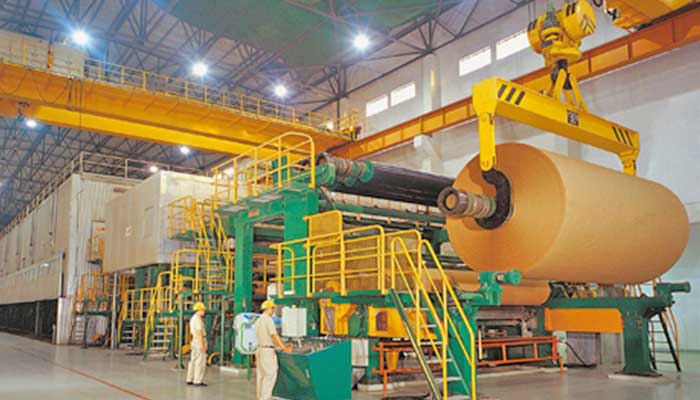
Paper Rolls
Overhead cranes are used in paper mills and printing plants to handle large paper rolls efficiently.
Types of Overhead Cranes used for Paper Rolls:
Double Girder Overhead Cranes: Ideal for lifting and transporting heavy paper rolls.
Spreader Beams: Custom-designed beams for secure attachment to paper rolls.
Telescopic Cranes: Used for lifting and positioning paper rolls at varying heights.
Features and Benefits:
Safe and efficient handling of delicate and heavy paper rolls.
Customized solutions for handling paper rolls of different sizes and weights.
Improved productivity in paper manufacturing and printing operations.
Best Application Environments and Conditions:
Paper mills, printing plants, and other facilities where large paper rolls are processed.
Locations with a need for precise and damage-free paper roll handling.
Typical Below Hook Devices used for Paper Roll Handling:
Custom-designed Spreader Beams: Created for securely lifting paper rolls from their cores.
Core Grippers: Specialized attachments for gripping paper rolls at their cores.
Chemical Containers
Chemical Containers: Overhead cranes assist in moving containers and drums filled with chemicals in chemical manufacturing facilities.
Types of Overhead Cranes used for Chemical Containers:
Single Girder Overhead Cranes: Suitable for general chemical container handling.
Explosion-Proof Cranes: Designed for safe operation in potentially explosive chemical environments.
Jib Cranes: Used for localized handling and positioning of chemical containers.
Features and Benefits:
Safe and precise handling of chemical containers, reducing the risk of spills or accidents.
Explosion-proof cranes ensure safety in hazardous chemical settings.
Efficient positioning and transportation of chemical containers.
Best Application Environments and Conditions:
Chemical manufacturing plants, processing facilities, and laboratories.
Locations where safe and precise chemical container handling is essential.
Typical Below Hook Devices used for Chemical Container Handling:
Chemical Container Hooks: Designed for securely gripping and transporting chemical drums.
Drum Lifters: Attachments for lifting and pouring chemicals from drums.
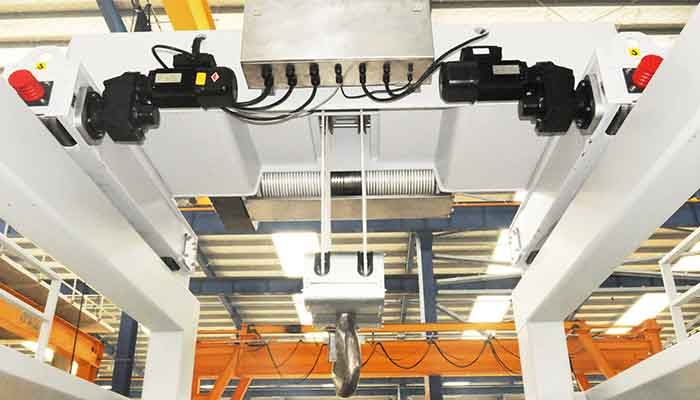
Food and Beverage Products
Food and Beverage Products: Overhead cranes assist in moving food and beverage products, such as packaged goods, raw materials, and bulk ingredients, within processing plants and warehouses.
Types of Overhead Cranes used for Food and Beverage Products:
Single Girder Overhead Cranes: Suitable for handling lighter food and beverage products.
Stainless Steel Cranes: Designed to meet hygiene standards in food processing environments.
Monorail Cranes: Used for linear and repetitive movement of food products along assembly lines.
Features and Benefits:
Hygienic handling of food and beverage products with stainless steel cranes.
Efficient movement of materials to support food and beverage production.
Customization to meet the specific requirements of the food processing industry.
Best Application Environments and Conditions:
Food processing plants, breweries, and beverage production facilities.
Locations where strict hygiene and food safety standards must be maintained.
Typical Below Hook Devices used for Food and Beverage Product Handling:
Custom Food-Grade Hooks: Designed for sanitary lifting and handling of food products.
Specialized Clamps: Attachments for securely gripping and transporting items like barrels and containers.
Textile Products
Textile Products: In textile mills and garment manufacturing facilities, overhead cranes help transport rolls of fabric, textile machinery, and finished products.
Types of Overhead Cranes used for Textile Products:
Double Girder Overhead Cranes: Ideal for lifting heavy textile rolls and machinery.
Jib Cranes: Used for localized handling and positioning of textile products.
Features and Benefits:
Efficient handling of textile products, optimizing material flow in textile facilities.
Customization to accommodate various textile sizes and weights.
Improved productivity in textile manufacturing and processing operations.
Best Application Environments and Conditions:
Textile mills, garment factories, and fabric processing facilities.
Locations where efficient and precise textile product handling is required.
Typical Below Hook Devices used for Textile Product Handling:
Textile Roll Grabs: Designed for securely gripping and transporting textile rolls.
Customized Hooks and Clamps: Tailored for the lifting and handling of textile products.
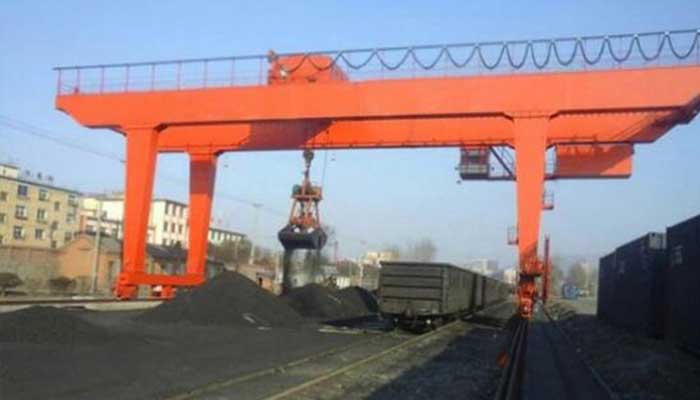
Mining Materials
Mining Materials: Overhead cranes are employed in mining operations to handle materials like ores, minerals, and rock.
Types of Overhead Cranes used for Mining Materials:
Double Girder Overhead Cranes: Designed for lifting and transporting heavy mining materials.
Specialized Mining Cranes: Custom-designed with features for mining environments, such as dust-resistant components.
Gantry Cranes: Used for outdoor mining material handling.
Features and Benefits:
Efficient handling of heavy and bulk mining materials, improving mining operations.
Customization to meet the specific requirements of the mining industry.
Durable components to withstand harsh mining environments.
Best Application Environments and Conditions:
Mining sites, open-pit mines, and underground mines.
Locations where the efficient and reliable handling of mining materials is crucial.
Typical Below Hook Devices used for Mining Material Handling:
Ore Grabs: Designed for securely gripping and transporting mining ores and minerals.
Rock Grapples: Attachments for handling large rock and debris.
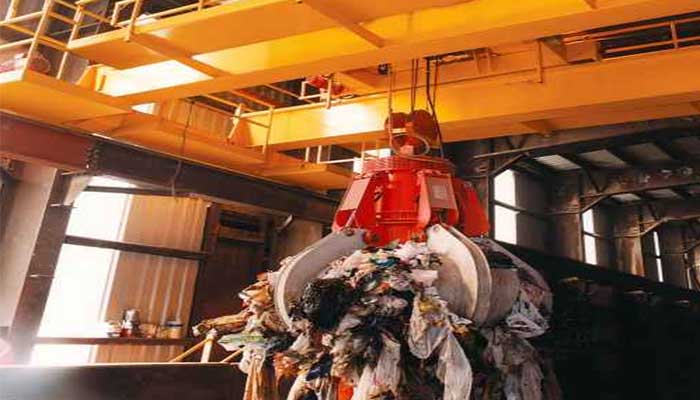
Waste Management
Waste Management: Overhead cranes play a role in waste management facilities for handling waste containers, recyclables, and bulk waste materials.
Types of Overhead Cranes used for Waste Management:
Double Girder Overhead Cranes: Designed for lifting and transporting heavy waste containers.
Specialized Waste Handling Cranes: Customized for waste management facilities.
Gantry Cranes: Used for outdoor waste material handling.
Features and Benefits:
Efficient handling of waste containers and recyclables to optimize waste management operations.
Customization to meet the specific requirements of waste management facilities.
Durable components to withstand the harsh and often dirty waste management environments.
Best Application Environments and Conditions:
Waste management facilities, recycling centers, and landfills.
Locations where the efficient and reliable handling of waste materials is vital.
Typical Below Hook Devices used for Waste Material Handling:
Waste Container Hooks: Designed for securely gripping and transporting waste containers.
Grapple Buckets: Attachments for handling bulk waste materials.
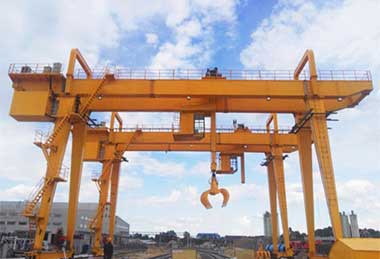
Woodworking Products
Woodworking Products: Overhead cranes are used in woodworking and carpentry industries for handling timber, boards, and finished wood products.
Types of Overhead Cranes used for Woodworking Products:
Double Girder Overhead Cranes: Designed for lifting and transporting heavy wooden materials.
Jib Cranes: Used for localized handling and positioning of wooden products.
Specialized Woodworking Cranes: Customized with features for woodworking environments.
Features and Benefits:
Efficient handling of wooden materials, optimizing woodworking and carpentry operations.
Customization to accommodate various wood sizes and weights.
Improved productivity in woodworking and carpentry shops.
Best Application Environments and Conditions:
Woodworking shops, sawmills, carpentry workshops, and furniture manufacturing facilities.
Locations where efficient and precise wooden product handling is essential.
Typical Below Hook Devices used for Woodworking Product Handling:
Custom-designed Hooks and Clamps: Tailored for the lifting and handling of wooden products.
Tailoring for Your Needs
Overhead cranes are renowned for their adaptability and versatility. They are designed to meet the diverse needs of various industries, whether it's handling unique load shapes or catering to specialized applications. In this section, we'll delve into the adaptability of overhead cranes for different load shapes and industries, providing real-world examples of customized solutions for challenging material handling tasks.
The Adaptability of Overhead Cranes:
One of the standout features of overhead cranes is their ability to be tailored to specific requirements. Whether you're dealing with unconventional load shapes or operating in specialized industries, overhead cranes can be customized to ensure optimal performance. Here are some key points to consider:
- Customized Lifting Devices: Overhead cranes can be equipped with a range of lifting devices, such as hooks, magnets, and specialized grippers, to suit the unique characteristics of the load.
- Variable Speed Control: The speed at which an overhead crane operates can be adjusted to match the specific needs of the application, allowing for careful handling of delicate materials or faster movement for efficiency.
- Control Systems: Advanced control systems can be integrated to enhance precision, accuracy, and safety. These systems can be tailored to the requirements of your operation.
Examples of Customized Solutions:
To illustrate the adaptability of overhead cranes, here are some real-world examples of customized solutions:
- Automotive Industry: In automotive manufacturing, overhead cranes are customized to handle a wide range of components, from engines to car bodies, with precision and care.
- Aerospace Sector: The aerospace industry often deals with delicate and complex components. Overhead cranes can be customized with specialized end effectors to handle aircraft parts with precision.
- Pharmaceutical Manufacturing: Overhead cranes in pharmaceutical facilities are adapted to meet strict hygiene and safety requirements, ensuring the secure handling of pharmaceutical materials.
- Waste Management: Customized overhead cranes are employed in waste management facilities to efficiently handle and sort various types of waste.
- Food and Beverage Processing: In food processing plants, overhead cranes are customized for sanitary handling, helping to maintain high food safety standards.
These examples demonstrate how overhead cranes can be tailored to meet the unique challenges of specific industries. The adaptability of these machines ensures that they are not a one-size-fits-all solution but a versatile tool that can be precisely configured to address the demands of your operation.
Automating Material Flow
In an era of advanced technology and industry evolution, automation plays a pivotal role in enhancing efficiency and productivity. Overhead cranes are not exempt from this trend. They have seamlessly integrated with automation systems to optimize material flow in various industries. In this section, we'll explore how overhead cranes are being used in automation, the advantages of this integration, and their role in Industry 0 and future advancements.
Integrating Automation with Overhead Cranes:
Automation and overhead cranes form a dynamic partnership that brings numerous benefits to material handling processes. Here's how they work together:
- Precision and Consistency: Automated overhead cranes can consistently perform precise movements, ensuring that materials are handled accurately and without variation.
- Reduced Labor: Automation reduces the need for manual labor, which not only cuts costs but also minimizes the risk of accidents and injuries.
- Optimized Workflows: Automated systems can be programmed to work seamlessly with other machinery and processes, streamlining the entire production cycle.
- 24/7 Operation: Automated overhead cranes can operate around the clock, improving productivity and reducing downtime.
The Role of Overhead Cranes in Industry and Beyond:
As Industry 0, the era of smart manufacturing, continues to shape the industrial landscape, overhead cranes are embracing this technological shift. They are becoming an integral part of the fourth industrial revolution, contributing to increased efficiency and competitiveness. Here are some key points to consider:
- Data-Driven Operations: Overhead cranes integrated with Industry 0 technologies can collect and analyze data, providing valuable insights for process optimization and predictive maintenance.
- Internet of Things (IoT) Integration: IoT sensors and devices can be incorporated into overhead crane systems, allowing for real-time monitoring and control from remote locations.
- Safety Enhancements: Automation and advanced sensor technologies improve safety by reducing the risk of human error and enabling rapid responses to potential issues.
- Future-Proofing: The adaptability of overhead cranes ensures they remain a future-proof solution, able to evolve with changing industry needs and technological advancements.
The integration of overhead cranes with automation not only optimizes material handling but also positions companies for a competitive edge in an increasingly tech-driven world. This fusion of precision, efficiency, and innovation is a testament to the enduring relevance and adaptability of overhead cranes in the modern industrial landscape.
Prioritizing Safety
Safety is paramount in material handling operations, and overhead crane operations are no exception. Emphasizing safety not only ensures the well-being of personnel but also safeguards materials and equipment. In this section, we'll discuss the critical importance of safety in overhead crane operations, provide guidelines on safety features, highlight the significance of operator training, and emphasize the need for compliance with industry standards.
Emphasizing Safety in Material Handling Operations:
The safe operation of overhead cranes is essential for preventing accidents and injuries. Safety measures should be integral to every aspect of material handling operations. Key considerations include:
- Risk Assessment: Prior to crane operation, a thorough risk assessment should be conducted to identify potential hazards and develop strategies to mitigate them.
- Proper Maintenance: Regular maintenance and inspections of overhead cranes are essential to identify and address any issues that could compromise safety.
- Load Capacity Awareness: Understanding and adhering to a crane's load capacity is crucial to prevent overloading and subsequent accidents.
- Safe Load Handling: Safe practices in securing loads and ensuring they are balanced help prevent accidents during material handling.
Guidelines on Safety Features:
Overhead cranes come equipped with a range of safety features to ensure the protection of both personnel and materials:
- Emergency Stop Buttons: These allow for the immediate cessation of crane movement in the event of an emergency.
- Overload Protection: Overhead cranes are often equipped with overload protection systems to prevent damage caused by excessive loads.
- Limit Switches: These prevent the crane from moving outside predetermined boundaries, reducing the risk of collisions and accidents.
- Collision Avoidance Systems: These systems use sensors to detect obstacles and prevent crane collisions.
Significance of Operator Training:
Operator training is a critical component of overhead crane safety. Well-trained operators are more likely to recognize potential hazards, operate cranes safely, and respond effectively in emergency situations. Proper operator training includes:
- Understanding Crane Operation: Operators should have a thorough understanding of how overhead cranes function, as well as the specific features and controls of the crane they operate.
- Safety Protocols: Operators must be well-versed in safety protocols and procedures, including load capacity limits and emergency response.
- Regular Refresher Training: Operator training should not be a one-time event. Regular refresher training ensures that operators stay current with safety guidelines and best practices.
Compliance with Industry Standards:
Compliance with industry standards and regulations is essential for ensuring the safety of overhead crane operations. These standards are designed to provide a framework for safe crane usage. Examples of industry standards include:
- OSHA (Occupational Safety and Health Administration): In the United States, OSHA sets forth safety regulations and guidelines for crane operations.
- CMAA (Crane Manufacturers Association of America): CMAA standards address various aspects of crane design, construction, and operation.
- ISO (International Organization for Standardization): ISO standards provide a globally recognized framework for crane safety.
Prioritizing safety in overhead crane operations is non-negotiable. By adhering to safety guidelines, implementing safety features, providing comprehensive operator training, and complying with industry standards, businesses can ensure the well-being of their personnel and the protection of valuable materials and equipment.
In the following sections, we'll explore how overhead cranes enhance efficiency and productivity, reduce costs, integrate with automation, and offer steps for implementation, frequently asked questions, a conclusion, and a call to action. These topics will provide a comprehensive guide for businesses looking to enhance their material loading and unloading processes with overhead cranes while maintaining the highest safety standards.
Enhancing Efficiency and Productivity
Efficiency and productivity are essential factors in any industrial operation. Overhead cranes play a pivotal role in optimizing material handling processes, significantly boosting efficiency, and enhancing productivity. In this section, we will delve into the ways overhead cranes contribute to efficiency and showcase real-life case studies and testimonials that demonstrate the notable productivity improvements they bring.
Demonstrating How Overhead Cranes Boost Material Handling Efficiency:
- Overhead cranes are designed with efficiency in mind, and their impact on material handling is profound. Here's how they elevate efficiency:
- Quick Material Movement: Overhead cranes can swiftly move materials from one location to another, reducing downtime and streamlining processes.
- Precise Load Placement: The accuracy of overhead cranes ensures that materials are placed exactly where they need to be, reducing the need for time-consuming adjustments.
- Reduced Manual Labor: By automating material handling, overhead cranes minimize the physical strain on workers and free up labor for other tasks.
- Optimized Workflows: Overhead cranes can be integrated into workflows, ensuring a smooth and efficient production process.
Case Studies and Testimonials Showcasing Productivity Improvements:
Real-life examples provide a tangible understanding of how overhead cranes enhance productivity. Let's take a look at some case studies and testimonials:
- Case Study 1: Manufacturing Facility: A manufacturing facility adopted overhead cranes to handle heavy components. Productivity increased by 25%, and material handling time was cut in half, resulting in significant cost savings.
- Case Study 2: Construction Site: A construction company implemented overhead cranes for moving construction materials. The streamlined process led to a 30% reduction in project completion time.
- Testimonial: Warehouse Operations: A warehouse manager praised overhead cranes for their role in accelerating the loading and unloading of goods. This efficiency led to a 20% reduction in labor costs and a 15% increase in order processing speed.
These real-world examples highlight the substantial impact that overhead cranes can have on productivity. They provide tangible evidence of efficiency gains and cost savings that are achievable with the integration of overhead cranes into material handling processes.
Cost-Effective Solutions
In today's competitive business landscape, cost-effectiveness is a key consideration for any investment. Overhead cranes, renowned for their efficiency and adaptability, offer long-term cost-effective solutions. In this section, we will explore the factors that make overhead cranes a cost-effective choice, including the reduction of labor costs and the potential for a higher return on investment (ROI).
The Long-Term Cost-Effectiveness of Overhead Cranes:
Overhead cranes are celebrated for their ability to deliver long-term cost savings. Here's why they are considered cost-effective:
- Reduced Labor Costs: By automating material handling tasks, overhead cranes significantly reduce the need for manual labor. This reduction not only leads to cost savings but also minimizes the risk of labor-related injuries and accidents.
- Efficient Material Handling: Overhead cranes excel at moving materials swiftly and accurately. This efficiency translates into cost savings by minimizing downtime and maximizing productivity.
- Long Lifespan: Overhead cranes are built to withstand heavy use. Their durability and longevity mean that the initial investment pays off over many years.
- Low Maintenance Costs: Regular maintenance is essential, but the maintenance costs of overhead cranes are relatively low compared to the benefits they provide.
Reduced Labor Costs:
One of the most significant cost-saving aspects of overhead cranes is the reduction in labor costs. Here's how overhead cranes help cut labor-related expenses:
- Minimized Manual Handling: Overhead cranes automate the movement of materials, reducing the need for manual handling. This not only lowers labor costs but also enhances workplace safety.
- Efficient Load Handling: Overhead cranes can handle heavy and bulky loads efficiently, often requiring fewer workers for the same tasks.
- Reduced Workforce Strain: Overhead cranes reduce physical strain on workers, decreasing the risk of injuries and absenteeism.
Potential for Higher ROI:
Investing in overhead cranes represents not just an expense but an opportunity for a higher return on investment. Here's how this potential is realized:
- Increased Productivity: Overhead cranes boost productivity by accelerating material handling. Faster processes often translate into more orders fulfilled and increased revenue.
- Reduced Downtime: The efficiency of overhead cranes minimizes downtime, ensuring that operations continue smoothly.
- Enhanced Safety: Safety enhancements provided by overhead cranes reduce the risk of accidents and their associated costs, including worker compensation and equipment damage.
- Competitive Advantage: Overhead cranes can position businesses ahead of competitors by streamlining processes, lowering costs, and meeting customer demands more efficiently.
The initial investment in overhead cranes is a strategic decision that pays dividends over time. Not only do they reduce labor costs, but they also enhance efficiency, safety, and overall operational effectiveness. This makes overhead cranes a cost-effective solution for various industries.
In the subsequent sections, we'll explore how overhead cranes integrate with automation systems, steps for their implementation, frequently asked questions, and conclude with a call to action. These topics will provide a comprehensive guide for businesses looking to enhance their material loading and unloading processes with overhead cranes while optimizing cost-effectiveness and ROI.
Integration with Automation
In an era of technological advancement, integrating overhead cranes with automation systems has become a game-changer in the material handling industry. This section explores the seamless fusion of overhead cranes and automation, highlighting the ways it maximizes efficiency, reduces manual labor, and enhances overall material flow.
Maximizing Efficiency Through Integration:
The integration of overhead cranes with automation systems is a strategic move to supercharge efficiency in material handling. Here's how this synergy takes efficiency to the next level:
- Precise Control: Automation systems enable precise control over load movements, minimizing the chances of errors and accidents.
- Workflow Optimization: Overhead cranes, when integrated with automation, can be seamlessly incorporated into workflow processes, ensuring materials move precisely where and when they are needed.
- Real-time Data: Automation systems provide real-time data on material flow, allowing for instant adjustments and improved decision-making.
- Reduced Downtime: The synergy between automation and overhead cranes results in significantly reduced downtime, leading to enhanced productivity.
Reducing Manual Labor:
Automation in conjunction with overhead cranes minimizes the reliance on manual labor. Here's how:
- Automated Load Handling: Automated systems take over the load handling process, eliminating the need for human operators in many instances.
- Safety Enhancements: Automation systems are equipped with safety features that reduce the risk of accidents, thereby decreasing the necessity for manual intervention.
- Lower Labor Costs: With reduced manual labor requirements, businesses benefit from lower labor costs and a safer working environment.
Improving Overall Material Flow:
The integration of overhead cranes with automation enhances the overall material flow within a facility. This improvement encompasses several aspects:
- Continuous Material Handling: Automation ensures continuous and uninterrupted material handling, resulting in a smoother production process.
- Material Tracking: Automation systems allow for precise tracking of materials, which is crucial for inventory management and order fulfillment.
- Material Flow Optimization: By automating material flow, businesses can optimize processes for efficiency, reduce bottlenecks, and improve customer service.
The integration of overhead cranes with automation is a strategic step towards creating a modern, efficient, and cost-effective material handling system. This innovative approach not only reduces manual labor and boosts efficiency but also empowers businesses to stay competitive in a rapidly evolving industrial landscape.
In the following sections, we will cover safety considerations, provide insights on how to enhance efficiency and productivity, discuss cost-effective solutions, and delve into the steps for implementing overhead cranes. We'll also address frequently asked questions and conclude with a compelling call to action. These topics offer a comprehensive guide for businesses seeking to optimize their material loading and unloading processes through the integration of overhead cranes and automation systems.
Implementation Guide
Implementing overhead cranes in your material handling processes can be a transformational step for your business. In this section, we provide a step-by-step guide to help you navigate the planning, installation, and maintenance phases. Whether you're considering your first overhead crane or upgrading an existing system, this guide will be your valuable companion.
- Step 1: Assess Your Material Handling Needs - Begin by evaluating your material handling requirements. Consider the types of materials you handle, the weight of loads, the frequency of handling, and the space available for crane installation.
- Step 2: Choose the Right Type of Overhead Crane - Select the type of overhead crane that best suits your needs. This decision should align with the assessment conducted in the previous step. The most common types include bridge cranes, gantry cranes, jib cranes, monorail cranes, stacker cranes, and container cranes.
- Step 3: Plan the Installation - Once you've chosen the right crane, plan the installation process. This includes selecting the installation location, ensuring proper structural support, and taking into account safety and operational requirements.
- Step 4: Consider Customization - Depending on your specific material handling needs, consider customizing your overhead crane. Customization can include adding specialized lifting attachments or adapting the crane's configuration to suit unique requirements.
- Step 5: Safety First - Safety is paramount. Prioritize safety features in your overhead crane system. Ensure that the crane is equipped with the necessary safety mechanisms and that your operators are well-trained in safe operation.
- Step 6: Installation and Testing - Once the planning is complete, proceed with the installation. This involves assembling the crane, ensuring structural integrity, and conducting comprehensive testing to confirm that the crane operates smoothly and safely.
- Step 7: Operator Training - Train your crane operators. Ensure they understand the controls, safety protocols, and operational guidelines. Skilled operators are critical to safe and efficient crane use.
- Step 8: Maintenance Plan - Develop a maintenance plan to keep your overhead crane in optimal working condition. Regular inspections, lubrication, and minor repairs are essential to prevent downtime and extend the crane's lifespan.
- Step 9: Monitor Performance - After implementation, monitor the crane's performance. Track its efficiency, safety record, and adherence to your material handling requirements. Use performance data to identify areas for improvement.
- Step 10: Continuous Improvement - Material handling needs can change over time. Be prepared to adapt your overhead crane system to meet evolving requirements. Consider periodic assessments to ensure your system remains efficient and cost-effective.
Implementing overhead cranes in your material handling processes can lead to significant improvements in efficiency, safety, and productivity. By following this implementation guide, you can navigate the process with confidence and enjoy the benefits of a well-designed and well-maintained overhead crane system.
In the following sections, we will delve into safety considerations, efficiency and productivity enhancements, cost-effective solutions, integration with automation, frequently asked questions, and conclude with a compelling call to action. These topics offer a comprehensive guide for businesses seeking to optimize their material loading and unloading processes through overhead crane solutions.
Frequently Asked Questions
We understand that businesses considering overhead cranes for their material handling needs may have questions. In this section, we provide answers to common client queries about overhead cranes and their applications. If you have any questions that aren't covered here, don't hesitate to reach out for personalized assistance and solutions.
Q1: What are the main types of overhead cranes used for truck loading and unloading?
A1: Overhead cranes come in various types, including Bridge Cranes, Gantry Cranes, Jib Cranes, Monorail Cranes, Stacker Cranes, and Container Cranes. The choice depends on the specific material handling requirements and the environment.
Q2: How can overhead cranes improve material handling efficiency?
A2: Overhead cranes are designed for precision and speed in material handling. They reduce manual labor, minimize downtime, and provide accurate load positioning, leading to enhanced efficiency and productivity.
Q3: Are overhead cranes safe to use in my facility?
A3: Yes, overhead cranes are safe when operated correctly and equipped with the necessary safety features. Proper operator training and adherence to safety protocols are essential to ensure safe operation.
Q4: Can overhead cranes be integrated with automation systems?
A4: Absolutely. Overhead cranes can be seamlessly integrated with automation systems to maximize efficiency and reduce manual labor. This integration is particularly beneficial in modern industrial settings.
Q5: What is the typical maintenance required for overhead cranes?
A5: Regular maintenance includes inspections, lubrication, and minor repairs. It's crucial to follow a maintenance plan to ensure the crane's long-term performance and safety.
Q6: Are overhead cranes cost-effective for my business?
A6: Overhead cranes are considered cost-effective due to reduced labor costs, increased efficiency, and long-term durability. They often result in a higher return on investment (ROI).
Q7: Can overhead cranes be customized to suit specific material handling needs?
A7: Yes, overhead cranes can be customized with specialized lifting attachments or configurations to meet unique material handling requirements. Customization enhances their adaptability.
Q8: How can I choose the right type of overhead crane for my business?
A8: Selecting the right type of overhead crane depends on your material handling needs. Consider factors such as load weight, frequency, space, and specific industry requirements.
Q9: Do overhead cranes require operator training, and where can I get it?
A9: Yes, operator training is essential for safe and efficient crane operation. Many organizations and training centers offer certified crane operator training programs.
Q10: What is the expected lifespan of an overhead crane?
A10: The lifespan of an overhead crane can vary depending on factors like usage and maintenance. However, with proper care, overhead cranes are built to last for many years.
We hope these answers have addressed some of your questions about overhead cranes. If you have more specific inquiries or require personalized guidance on your material handling needs, please don't hesitate to reach out. We're here to help you find the right solutions for your business.
In the next section, we'll conclude with a summary of the key takeaways from this article, and a compelling call to action for those looking to enhance their material loading and unloading processes.
Conclusion
In the journey through this comprehensive guide, we've explored the world of overhead cranes and their pivotal role in enhancing material handling processes. From the loading and unloading of palletized goods to the handling of heavy machinery and shipping containers, overhead cranes offer tailored solutions that optimize efficiency and productivity across a spectrum of industries.
Here are the key takeaways from our exploration:
- Overhead cranes come in various types, each tailored for specific material handling applications, ensuring precise and efficient operations.
- Safety is a paramount consideration when it comes to overhead cranes, and proper operator training and adherence to safety protocols are crucial.
- The integration of overhead cranes with automation systems opens the door to a new era of material handling efficiency, reducing manual labor and improving overall material flow.
- Overhead cranes are not only cost-effective but also offer long-term durability, making them an excellent investment with a promising return on investment (ROI).
- Customization options are available to meet unique material handling requirements, enhancing the adaptability of overhead cranes.
- Implementing overhead cranes in your material handling processes requires careful planning, installation, and maintenance, ensuring a smooth and efficient operation.
As we conclude this article, we encourage you to take the next step in optimizing your material loading and unloading processes. Whether you're considering overhead cranes for the first time or looking to upgrade your existing system, our team of experts is here to provide you with tailored solutions.
At our crane factory, we understand the unique challenges and opportunities that material handling presents to businesses. Our commitment to excellence and innovation drives us to offer the best in overhead crane technology and services. We invite you to reach out to us for expert guidance and customized solutions that will revolutionize your material handling processes.
With overhead cranes as your trusted partners in material handling, you can expect enhanced efficiency, safety, and productivity, positioning your business for success in the competitive landscape of today and tomorrow.
Thank you for embarking on this journey with us, and we look forward to being your partner in material handling excellence.
In the journey through this comprehensive guide, we've explored the world of overhead cranes and their pivotal role in enhancing material handling processes. From the loading and unloading of palletized goods to the handling of heavy machinery and shipping containers, overhead cranes offer tailored solutions that optimize efficiency and productivity across a spectrum of industries.
Here are the key takeaways from our exploration:
- Overhead cranes come in various types, each tailored for specific material handling applications, ensuring precise and efficient operations.
- Safety is a paramount consideration when it comes to overhead cranes, and proper operator training and adherence to safety protocols are crucial.
- The integration of overhead cranes with automation systems opens the door to a new era of material handling efficiency, reducing manual labor and improving overall material flow.
- Overhead cranes are not only cost-effective but also offer long-term durability, making them an excellent investment with a promising return on investment (ROI).
- Customization options are available to meet unique material handling requirements, enhancing the adaptability of overhead cranes.
- Implementing overhead cranes in your material handling processes requires careful planning, installation, and maintenance, ensuring a smooth and efficient operation.
As we conclude this article, we encourage you to take the next step in optimizing your material loading and unloading processes. Whether you're considering overhead cranes for the first time or looking to upgrade your existing system, our team of experts is here to provide you with tailored solutions.
At our factory, we understand the unique challenges and opportunities that material handling presents to businesses. Our commitment to excellence and innovation drives us to offer the best in overhead crane technology and services. We invite you to reach out to us for expert guidance and customized solutions that will revolutionize your material handling processes.
With overhead cranes as your trusted partners in material handling, you can expect enhanced efficiency, safety, and productivity, positioning your business for success in the competitive landscape of today and tomorrow. If you have any need of overhead cranes for truck loading and unloading, please feel free to contact us.
